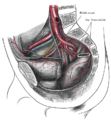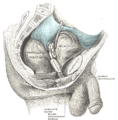- Chronic bacterial prostatitis
-
Chronic Bacterial Prostatitis Classification and external resources 
ICD-10 N41.1 ICD-9 601.1 DiseasesDB 10801 MedlinePlus 000523 eMedicine med/1920 MeSH D011472 Chronic bacterial prostatitis is a bacterial infection of the prostate gland. It should be distinguished from other forms of prostatitis such as acute bacterial prostatitis and chronic pelvic pain syndrome (CPPS).
Contents
Signs and symptoms
Chronic bacterial prostatitis is a relatively rare condition — occurs in less than 5% of patients with prostate-related non-BPH lower urinary tract symptoms (LUTS) — that usually presents with an intermittent UTI-type picture and that is defined as recurrent urinary tract infections in men originating from a chronic infection in the prostate. Dr. Weidner, Professor of Medicine, Department of Urology, University of Gießen, has stated: "In studies of 656 men, we seldom found chronic bacterial prostatitis. It is truly a rare disease. Most of those were E-coli."[1] Symptoms may be completely absent until there is also bladder infection, and the most troublesome problem is usually recurrent cystitis.[2]
Diagnosis
In chronic bacterial prostatitis there are bacteria in the prostate, but there may be no symptoms or milder symptoms than occur with acute prostatitis.[3] The prostate infection is diagnosed by culturing urine as well as prostate fluid (expressed prostatic secretions or EPS) which are obtained by the doctor doing a rectal exam and putting pressure on the prostate. If no fluid is recovered after this prostatic massage, a post massage urine should also contain any prostatic bacteria. Prostate specific antigen levels may be elevated, although there is no malignancy. Semen analysis is a useful diagnostic tool.[4]
Treatment
Treatment requires prolonged courses (4–8 weeks) of antibiotics that penetrate the prostate well[5] (nitrofurantoin and most β-lactams are ineffective). These include quinolones (ciprofloxacin, levofloxacin), sulfas (Bactrim, Septra), doxycycline and macrolides (erythromycin, clarithromycin). Persistent infections may be helped in 80% of patients by the use of alpha blockers (tamsulosin (Flomax), alfuzosin), or long term low dose antibiotic therapy.[6] Recurrent infections may be caused by inefficient urination (benign prostatic hypertrophy, neurogenic bladder), prostatic stones or a structural abnormality that acts as a reservoir for infection.
Escherichia coli extract and cranberry have a potentially preventive effect on the development of CBP.[7]
The addition of prostate massage to courses of antibiotics was previously proposed as being beneficial.[8][9] However, in more recent trials, this was not shown to improve outcome compared to antibiotics alone.[10]
Prognosis
Over time, the relapse rate is high, exceeding 50%. A 2007 study showed that repeated courses of combination antibiotics may eradicate infection in 83.9% of patients with clinical remission extending throughout a follow-up period of 30 months for 94% of these patients.[11]
References
- ^ Schneider H, Ludwig M, Hossain HM, Diemer T, Weidner W (2003). "The 2001 Gießen Cohort Study on patients with prostatitis syndrome--an evaluation of inflammatory status and search for microorganisms 10 years after a first analysis". Andrologia 35 (5): 258–62. doi:10.1046/j.1439-0272.2003.00586.x. PMID 14535851.
- ^ Habermacher GM, Chason JT, Schaeffer AJ (2006). "Prostatitis/chronic pelvic pain syndrome". Annu. Rev. Med. 57 (1): 195–206. doi:10.1146/annurev.med.57.011205.135654. PMID 16409145.
- ^ NHS Choices. Prostatitis - Symptoms.http://www.nhs.uk/conditions/prostatitis/pages/symptoms.aspx
- ^ Magri V, Wagenlehner FM, Montanari E, et al. (April 2009). "Semen analysis in chronic bacterial prostatitis: diagnostic and therapeutic implications". Asian J. Androl. 11 (4): 461–77. doi:10.1038/aja.2009.5. PMID 19377490.
- ^ Charalabopoulos K, Karachalios G, Baltogiannis D, Charalabopoulos A, Giannakopoulos X, Sofikitis N (2003). "Penetration of antimocrobial agents into the prostate". Chemotherapy 49 (6): 269–279. doi:10.1159/000074526. PMID 14671426.</http://home.swipnet.se/isop/Penetration.pdf
- ^ Shoskes DA, Hakim L, Ghoniem G, Jackson CL (2003). "Long-term results of multimodal therapy for chronic prostatitis/chronic pelvic pain syndrome". J. Urol. 169 (4): 1406–10. doi:10.1097/01.ju.0000055549.95490.3c. PMID 12629373.
- ^ Kim, SH.; Ha, US.; Lee, HR.; Sohn, DW.; Lee, SJ.; Kim, HW.; Han, CH.; Lee, CB. et al. (Nov 2010). "Do Escherichia coli extract and cranberry exert preventive effects on chronic bacterial prostatitis? Pilot study using an animal model.". J Infect Chemother. doi:10.1007/s10156-010-0170-5. PMID 21042827.
- ^ Nickel JC, Downey J, Feliciano AE, Hennenfent B (1999). "Repetitive prostatic massage therapy for chronic refractory prostatitis: the Philippine experience". Techniques in urology 5 (3): 146–51. PMID 10527258.
- ^ Shoskes DA, Zeitlin SI (1999). "Use of prostatic massage in combination with antibiotics in the treatment of chronic prostatitis". Prostate Cancer and Prostatic Diseases 2 (3): 159–162. doi:10.1038/sj.pcan.4500308. PMID 12496826.
- ^ Ateya A, Fayez A, Hani R, Zohdy W, Gabbar MA, Shamloul R (2006). "Evaluation of prostatic massage in treatment of chronic prostatitis". Urology 67 (4): 674–8. doi:10.1016/j.urology.2005.10.021. PMID 16566972.
- ^ Magri V, Trinchieri A, Pozzi G, et al. (May 2007). "Efficacy of repeated cycles of combination therapy for the eradication of infecting organisms in chronic bacterial prostatitis". Int. J. Antimicrob. Agents 29 (5): 549–56. doi:10.1016/j.ijantimicag.2006.09.027. PMID 17336504.
External links
Additional images
Male diseases of the pelvis and genitals (N40–N51, 600–608) Internal ProstateProstatitis (Acute prostatitis, Chronic bacterial prostatitis, Chronic prostatitis/chronic pelvic pain syndrome, Asymptomatic inflammatory prostatitis) · Benign prostatic hyperplasiaExternal PenisBalanoposthitis/Balanitis · Phimosis · Priapism · Sexual dysfunction (Erectile dysfunction) · Peyronie's disease · Penile cancer · Penile fracture · Balanitis xerotica obliteransOther Categories:- Bacterial diseases
- Sexually transmitted diseases and infections
- Prostate disorders
Wikimedia Foundation. 2010.



